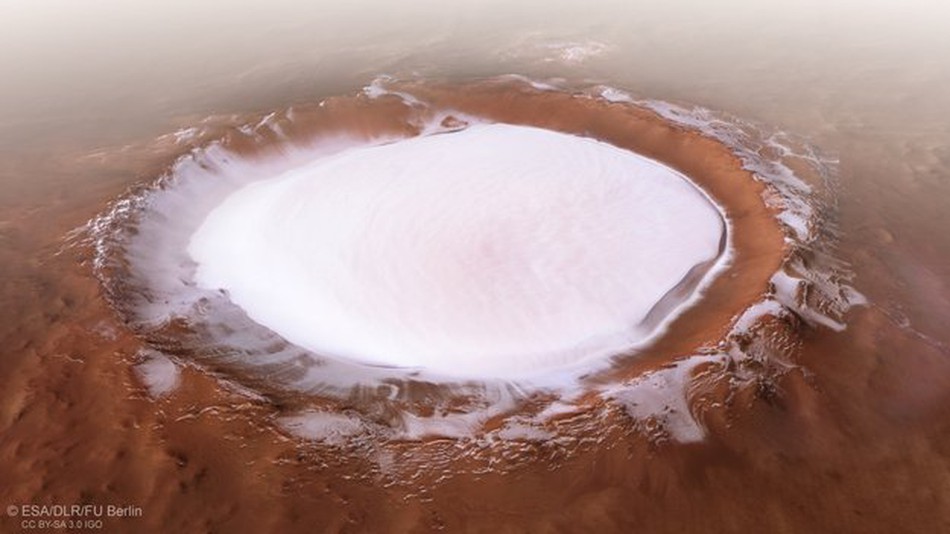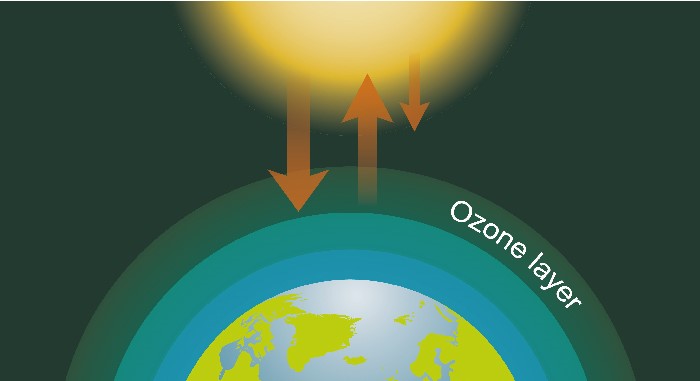The Mars orbiter has obtained a stunning view of a feature called the Korolev crater, an 81.4-kilometre (50.6-mile) diameter crater just south of the Olympia Undae dunes circling the northern polar cap. The crater is filled almost to the brim with pristine ice year-round.
Like Earth, Mars has ice caps at its poles. Water reaches the poles as vapor and is frozen into thin layers that build up thick deposits. Mixed with this water is dust picked up by the wind, so the caps have bright and dark layers of "clean" and "dirty" ice.
During winter at each pole, temperatures are so low that carbon dioxide freezes from the atmosphere and forms additional layers of "dry ice." Much water is also trapped as permafrost surrounding the polar regions.
Mars is special because it is the only planet in our solar system that has a dynamical climate like Earth. Observations and measurements from different satellites show that in the present climate on Mars, water mainly exists in large ice caps at the poles (in the scientific community called the Polar Layered Deposits, PLD), in the ground as permafrost on the mid- and high latitudes, and as frost patches and ancient glaciers scattered around the surface of the planet.
The atmosphere on Mars is much thinner than our atmosphere and has an entirely different composition. While Earth's atmosphere contain about 0.4% CO2 and about 1% water, CO2 is the main part of the Martian atmosphere that only contains 0.05% water.
In contrast to the ice covered areas at high latitudes, the glaciers on the low latitudes do not originate from the current climate period, since the temperatures currently are too high for glaciers to form. They are remnants from older periods with different climate conditions caused by shifts in the rotation axis of the planet. The ice is now stored underneath a layer of dust and rocks that protects it from melting despite high temperatures on the surface.
The Martian ground ice is deposited inside the porous soil (called the regolith) in various depths mainly depending on the latitude. In some areas at high latitude, around 50% of the mass in the underground is ice and the ground ice lies very close to the surface. The origin of the ground ice is still being discussed in the scientific community. Many theories consider the origin of the ice as a combination of frozen ancient oceans, upwelling from subsurface water reservoirs, and the ice being deposited under current climate conditions, where water is exchanged with the other water reservoirs through the atmosphere.
The two PLD are located in the polar regions of Mars and are currently the largest known water reservoirs on the planet. The north PLD has a diameter of around 1000 km and the south PLD is around 1500 km, comparable to the size of the Greenland ice sheet on Earth.
Both the north and the south PLD consist of layers of water ice, dust and CO2 ice, deposited through millions of years.
The winters on Mars are so cold that the CO2 in the atmosphere freezes out (freezing point -126°C), so both the north and the south PLD are covered by a thick layer of seasonal CO2-snow in the winter season. Both the north and the south PLD have a distinctive upper layer, which can be seen as the white patches on the pictures. In the north, this layer consists of water ice, which covers the underlying deposits. In the south, it consists of a layer of CO2 ice with a thickness of a couple of meters that only covers a small part of the underlying water ice, which is covered by a layer of dust. This makes the south PLD look much smaller than it really is.
Both the north and the south PLD have a very distinctive spiraling pattern that is counterclockwise in the north and clockwise in the south. The origin of the pattern is not fully understood but research has suggested that it could be formed by a combination of patterns of winds and incoming solar radiation.

While the presence of liquid water on Mars remains an ongoing topic of intense interest, we know that there is plenty of water ice adorning the Red Planet - and boy can it ever look amazing, as new images from the European Space Agency's Mars Express attest.




